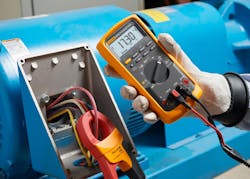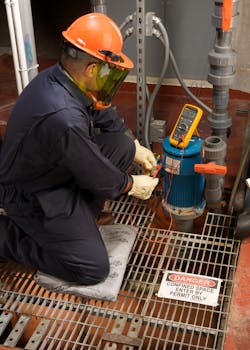Single-phase motors are common in many industries and can be found in blowers, pumps, fans, lathes, and numerous other types of equipment. Single-phase motor failures or malfunctions can often be traced to issues with the centrifugal switch, thermal switch, or capacitor(s). These problems can typically be fixed by servicing, repairing, or replacing these components. On a motor older than 10 yr or less than 1 hp, however, the motor is usually replaced. Since the cost of repair often exceeds the cost of a new one, small motors less than 1/8 hp are also typically replaced.
Split-Phase Motor Troubleshooting
A split-phase motor is a common type of single-phase motor that includes both a starting and running winding. A centrifugal switch automatically disconnects the starting winding when the motor reaches operating speed. A thermal switch is added to some split-phase motors, which automatically trips and turns the motor off if it overheats. Thermal switches might include automatic or manual resets. Since automatic resets could restart the motor at any time, extra safety precautions should be taken when troubleshooting a motor with an automatic reset.
Steps for troubleshooting a split-phase motor include:
Troubleshooting Capacitor Motors
A capacitor motor is a type of split-phase motor that includes one or two capacitors to provide the motor more starting and/or running torque. Troubleshooting capacitor motors is the same as troubleshooting split-phase motors (see above), but also takes into consideration the capacitor.
Capacitors deteriorate over time and thus have a limited life span. Capacitors often are the cause of problems with a capacitor motor. Capacitors can have a short circuit, an open circuit, or can deteriorate to the point where they need to be replaced. Deterioration can also change the value of a capacitor, which can cause more problems. When a capacitor short-circuits, the winding in the motor may burn out. When a capacitor deteriorates or opens, the motor often does not have the proper torque to easily start. If the motor is prevented from starting, then overloads are usually tripped.
Take the following steps when troubleshooting capacitor motors:
Sidebar: Capacitors 101
All capacitors consist of two conducting surfaces, which are separated by dielectric material. Dielectric material is a medium in which an electric field is maintained with little or no outside energy supply. It is the type of material used to insulate conducting surfaces of a capacitor. Two of the more common capacitor types found in motors are oil and electrolytic. Oil capacitors are filled with oil and sealed in a metal container. The oil serves as the dielectric material.
Electrolytic capacitors are more common in motors than oil capacitors. These electrolytic capacitors are formed by winding two thin sheets of aluminum separated by pieces of paper infused with an electrolyte. An electrolyte is a conducting medium in which the current flow occurs by ion migration. The electrolyte is used as the dielectric material. The aluminum sheets and electrolyte are encased in a cardboard or aluminum cover. A vent hole prevents a possible explosion in the event the capacitor is shorted or overheated.
AC capacitors are used with capacitor motors. Capacitors that are designed to be connected to AC may have no polarity.
Silva has been with Fluke for more than 20 years, working in various roles from field service and metrology to product management. He holds a B.S. in Business and an M.B.A. in Technology Management. He can be reached at [email protected].
About the Author
Luis Silva
Silva has been with Fluke for more than 20 years, working in various roles from field service and metrology to product management. He holds a B.S. in Business and an M.B.A. in Technology Management.


